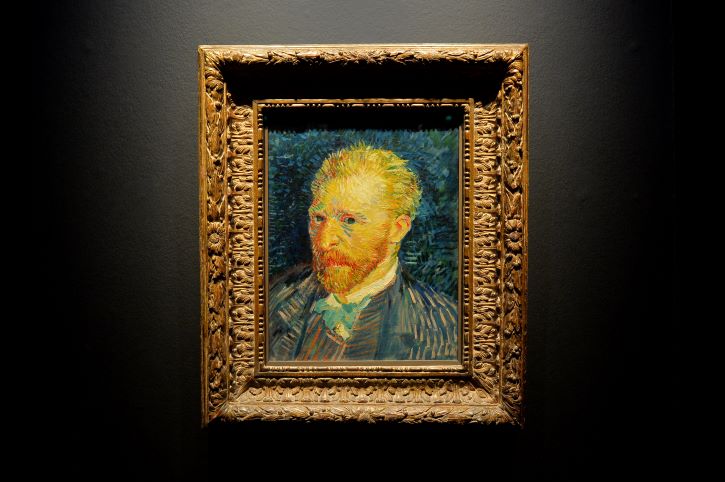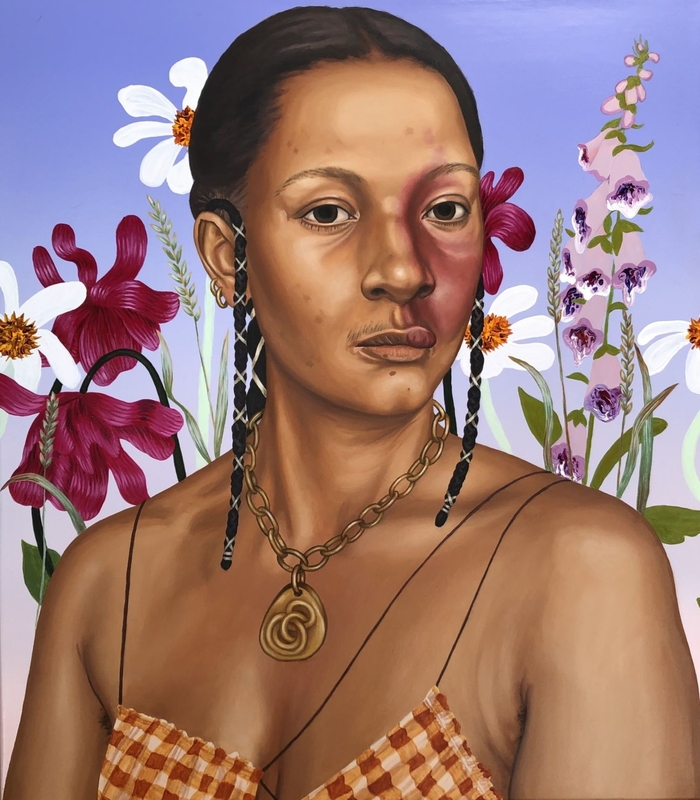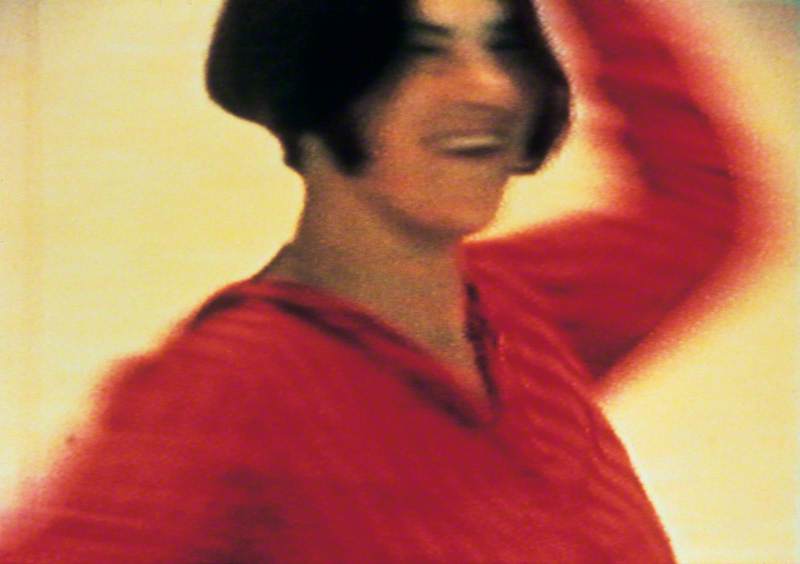Since my arrival in Cardiff, Amgueddfa Cymru has been a cornerstone of my experience here. Most recently, my curiosity was ignited by the 'Art of the Selfie' exhibition. The exhibition poses the question 'is the self portrait the original selfie?' and invites us to explore the complex nature of self portraiture and its parallels with our online self-curation.
Self portraits and selfies share an elemental kinship – capturing a moment of the self in time. Walking through the exhibition's dark-walled gallery, it struck me how each work highlighted the connection between these two forms of self-expression while also reflecting the diversity of self portraiture as a whole.
Anya Paintsil's Blod stands out boldly against the gallery's dark walls. With its textured pastel-purple background and flowing threads, it offers a refreshing take on portraiture. The figure is a play on Blodeuwedd, a central character from the Mabinogion, the earliest prose stories in Britain, rooted in Welsh oral tradition.
The artist blends her Welsh and Ghanaian heritage by combining traditional hand rug-making techniques learnt from her Welsh grandmother with afro hair styling methods. Our identities are deeply personal, yet they are shaped by our cultural heritage, society, relationships, and experiences. For many, these deeply personal identities also carry political weight. Paintsil's portrait offers insight into her own identity while reflecting the richness and diversity of Wales, and the complexities of blended cultural heritage.
Paintsil's figure stands with a long, distorted arm lifted to frame her face, flowers freckling the portrait. The bold, flat colours create the perfect backdrop for the figure's expression – an expression that's difficult to name. Unlike the typical smile of a selfie or the solemnity often seen in traditional self portraits, for me, the gritted teeth of Paintsil's figure more accurately convey the complexities of identity. The composition feels alive, as though the figure is caught mid-movement, highlighting the challenge of capturing an ever-evolving self in a single moment.
In contrast to the contemporary art of Paintsil, the exhibition focuses on a self portrait by Vincent van Gogh, on loan from the Musée d’Orsay in Paris. Van Gogh painted over 35 self portraits in his lifetime, and his struggles with mental health are as well known as his art. Each brushstroke in Portrait of the Artist stands out boldly against the backdrop of the gallery.

Image credit: Amgueddfa Cymru
Portrait of the Artist
1887, oil on canvas by Vincent van Gogh (1853–1890), on loan from Musée d'Orsay
Contrasting with the colourful self portrait is my knowledge of the darker side of Van Gogh's life and struggles. I found myself unable to view the portrait independently of what I knew of the artist.
There is something quite intentional and intimate about a self portrait. It's an artist's invitation for you to see them, as they see themselves, or perhaps how they feel in that moment. Looking at Van Gogh's self portrait I wondered about the impact his biography has on how we view his work.
While Van Gogh's painting made me reflect how an artist's biography informs our viewing of their self portraits, Edna Clarke Hall's Self-portrait and Self-portrait as a Girl inspired me to think about the way a self portrait can be a reflection of society as well as the individual pictured. Her works, often featuring herself and her children, are deeply rooted in the domestic sphere, reflecting the limited opportunities available to her as a woman and an artist.
In conversation with the exhibition curator, it was highlighted to me that Hall's use of herself and her children as models was a necessity, driven by the constraints of her physical, and social, environment. Many female artists of Clarke Hall's time operated under similar constraints.

© the artist's estate. Image credit: Amgueddfa Cymru – National Museum Wales
Self Portrait on Garnedd Dafydd 1938
Brenda Chamberlain (1912–1971)
Amgueddfa Cymru – National Museum WalesBrenda Chamberlain's Self Portrait on Garnedd Dafydd explores identity beyond gender. The intensity of the figure's stare, the shadowy figures in the background, and the contrast between bold brushstrokes and seamless blending draw the viewer in. Unlike a selfie, which can be taken in an instant, Chamberlain's self portrait reflects the hours of introspection she took to capture a likeness.
The Welsh landscape in the background is more than a setting: it's an extension of the artist herself. The shadowy background figures are seemingly out of place and add a sense of tension. They perhaps suggest the complex influences that external figures can have on shaping one's identity.
Another fascinating piece in the exhibition is the series of Christmas cards by Angus McBean. These cards, produced annually from 1936 to 1980, except for two years when McBean was imprisoned for being gay, offer a poignant commentary on the societal treatment of LGBTQ+ individuals. Although not mentioned in the exhibition label due to space restraints, such details are important in helping us understand the artist's life and work.
The self portraits in this case act as a time capsule, documenting McBean's skill and physical appearance as they developed each Christmas. The absence of self portraits in the year he was imprisoned documents the attitude towards gay men in society at the time.
Portrait of the Artist: Tête farouche by Augustus Edwin John provides a contrast to the other works. This incomplete sketch showcases the artist's skill while offering a glimpse into the process of creating art. The accompanying exhibition label sheds light on John's controversial history, particularly his exploitation of women, prompting reflection on how we remember historical figures. Self portraiture is not only about how we see ourselves but also about how society shapes our identities.

© the artist's estate / Bridgeman Images. Image credit: Amgueddfa Cymru – National Museum Wales
Portrait of the Artist: 'Tete farouche' 1906
Augustus Edwin John (1878–1961)
Amgueddfa Cymru – National Museum Wales'Art of the Selfie' is curated with passion and thoughtfulness, offering a space to explore what makes a self portrait. Is it about accurately portraying oneself, reflecting on relationships, or capturing the society we live in and our role in it? Ultimately, the exhibition suggests that identity is complex, and self portraits are attempts to explore this complexity through art.
So, is the self portrait the original selfie? I believe it is. But don't just take my word for it – visit the exhibition, take a selfie and find out for yourself.
Abike Ogunlokun, freelance creative
This content was supported by Welsh Government funding
'Art of the Selfie' is on display at National Museum Cardiff from 16th March 2024 to 26th January 2025. It marks the first time the Van Gogh self portrait has visited Wales. In exchange, Amgueddfa Cymru's much-loved La Parisienne by Renoir – also known as 'The Blue Lady' – has made its journey across the Channel. This loan agreement closes the Welsh Government's dedicated year of Wales in France, which has created ties between the two countries in trade, culture and sport.
Discover more selfies on Art UK with a series of Curations featuring self portraits by 1,000 artists































